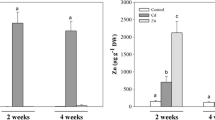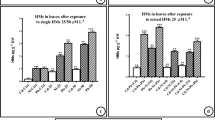Abstract
Aims
Metal chemical forms and subcellular partitioning model (SPM) in organisms can provide valuable insights into metal toxicity.
Methods
Two cultivars of lettuce (Lactuca sativa L.) were grown in Cd and Cu contaminated soils and chemical forms and subcellular distribution of Cd and Cu within the lettuce shoots were determined.
Results
Examination of the inhibition of superoxide dismutase (SOD) and catalase (CAT) activities, as well as the production of H2O2 showed that Lactuca sativa L. var. longifolia is more sensitive to metal-stress than is Lactuca sativa L. var. crispa. In L. crispa, the majority of accumulated Cd was in the pectate- and protein-integrated forms (53.7–62.9 %), while in L. longifolia, a higher proportion of the Cd was in the water soluble forms (33.0–39.2 %) and in the organelles fraction – these forms being potentially associated with toxicity. The chemically-based chemical form approach agreed closely with independent biologically-based SPM, as demonstrated by their significant linear relationships.
Conclusions
This study provides a first step towards the integration of chemical form approach and SPM into a common mechanistic framework, which is important for predicting the likelihood of toxic effects of metals in the environment of interest.






Similar content being viewed by others
References
Ahmad P, Nabi G, Ashraf M (2011) Cadmium-induced oxidative damage in mustard [Brassica juncea (L.) Czern. & Coss.] plants can be alleviated by salicylic acid. S Afr J Bot 77:36–44
Apel K, Hirt H (2004) Reactive oxygen species: metabolism, oxidative stress, and signal transduction. Annu Rev Plant Biol 55:373–399
Brennan T, Frenkel C (1977) Involvement of hydrogen peroxide in the regulation of senescence in pear. Plant Physiol 59:411–416
Chen F, Wang F, Wu F, Mao W, Zhang G, Zhou M (2010) Modulation of exogenous glutathione in antioxidant defense system against Cd stress in the two barley genotypes differing in Cd tolerance. Plant Physiol and Biochem 48:663–672
Clemens S (2006) Toxic metal accumulation, responses to exposure and mechanisms of tolerance in plants. Biochimie 88:1707–1719
Dang F, Rainbow PS, Wang W-X (2012) Dietary toxicity of field-contaminated invertebrates to marine fish: Effects of metal doses and subcellular metal distribution. Aquat Toxicol 120–121:1–10
Davies BE, White HM (1981) Trace elements in vegetables grown on soils contaminated by base metal mining. J Plant Nutr 3:387–396
Del Río LA, Sevilla F, Sandalio LM, Palma JM (1991) Nutritional effect and expression of SODs: induction and gene expression; diagnostics; prospective protection against oxygen toxicity. Free Radic Res Commun 12–13:819–827
Draper HH, Hadley M (1990) Malondialdehyde determination as index of lipid-peroxidation. Method Enzymol 186:421–431
Farago ME, Pitt MJ (1977) Plants which accumulate metals. Part II. An investigation of the soluble zinc containing extracts from two Australian species. Inorg Chim Acta 24:127–130
Fossati P, Prencipe L, Berti G (1980) Use of 3, 5-dichloro-2-hydroxybenzenesulfonic acid/4-aminophenazone chromogenic system in direct enzymic assay of uric acid in serum and urine. Clin Chem 26:227–231
Fu X, Dou C, Chen Y, Chen X, Shi J, Yu M, Xu J (2011) Subcellular distribution and chemical forms of cadmium in Phytolacca americana L. J Hazard Mater 186:103–107
Ginocchio R, Rodríguez PH, Badilla-Ohlbaum R, Allen HE, Lagos GE (2002) Effect of soil copper content and pH on copper uptake of selected vegetables grown under controlled conditions. Environ Toxicol Chem 21:1736–1744
Hall JL (2002) Cellular mechanisms for heavy metal detoxification and tolerance. J Exp Bot 53:1–11
Haynes RJ (1980) Ion exchange properties of roots and ionic interactions within the root apoplasm: their role in ion accumulation by plants. Bot Rev 46:75–99
Heath RL, Packer L (1968) Photoperoxidation in isolated chloroplasts: I. Kinetics and stoichiometry of fatty acid peroxidation. Arch Biochem Biophys 125:189–198
Huang B, Kuo S, Bembenek R (2004) Availability of cadmium in some phosphorus fertilizers to field-grown lettuce. Water Air Soil Pollut 158:37–51
Isaure MP, Fayard B, Sarret G, Pairis S, Bourguignon J (2006) Localization and chemical forms of cadmium in plant samples by combining analytical electron microscopy and X-ray spectromicroscopy. Spectrochimica Acta B 61:1242–1252
Jarvis SC, Jones LHP, Hopper MJ (1976) Cadmium uptake from solution by plants and its transport from roots to shoots. Plant Soil 44:179–191
Koren Š, Arčon I, Kump P, Nečemer M, Vogel-Mikuš K (2013) Influence of CdCl2 and CdSO4 supplementation on Cd distribution and ligand environment in leaves of the Cd hyperaccumulator Noccaea (Thlaspi) praecox. Plant Soil 370:125–148
Kuboi T, Noguchi A, Yazaki J (1986) Family-dependent cadmium accumulation characteristics in higher plants. Plant Soil 92:405–415
Lavoie M, Le Faucheur S, Fortin C, Campbell PGC (2009) Cadmium detoxification strategies in two phytoplankton species: Metal binding by newly synthesized thiolated peptides and metal sequestration in granules. Aquat Toxicol 92:65–75
León AM, Palma JM, Corpas FJ, Gómez M, Romero-Puertas MC, Chatterjee D, Mateos RM, del Río LA, Sandalio LM (2002) Antioxidative enzymes in cultivars of pepper plants with different sensitivity to cadmium. Plant Physiol Biochem 40:813–820
Li D, Zhou D, Wang P, Li L (2011) Temperature affects cadmium-induced phytotoxicity involved in subcellular cadmium distribution and oxidative stress in wheat roots. Ecotox Environ Safe 74:2029–2035
Liu DH, Kottke I (2004) Subcellular localization of cadmium in the root cells of Allium cepa by electron energy loss spectroscopy and cytochemistry. J Biosci 29:329–335
Lozano-Rodríguez E, Hernández LE, Bonay P, Carpena-Ruiz RO (1997) Distribution of cadmium in shoot and root tissues of maize and pea plants: physiological disturbances. J Exp Bot 48:123–128
Lu H, Liu B, Zhang Y, Ye J, Yan C (2014) Comparing analysis of elements sub-cellular distribution in Kandelia obovata between SEM-EDX and chemical extraction. Aquat Bot 112:10–15
Lux A, Martinka M, Vaculík M, White PJ (2011) Root responses to cadmium in the rhizosphere: a review. J Exp Bot 62:21–37
Ma JF, Ueno D, Zhao FJ, McGrath SP (2005) Subcellular localisation of Cd and Zn in the leaves of a Cd-hyperaccumulating ecotype of Thlaspi caerulescens. Planta 220:731–736
Metwally A, Safronova VI, Belimov AA, Dietz KJ (2005) Genotypic variation of the response to cadmium toxicity in Pisum sativum L. J Exp Bot 56:167–178
Monteiro MS, Santos C, Soares AMVM, Mann RM (2009) Assessment of biomarkers of cadmium stress in lettuce. Ecotox Environ Safe 72:811–818
Nishizono H, Ichikawa H, Suziki S, Ishii F (1987) The role of the root cell wall in the heavy metal tolerance of Athyrium yokoscense. Plant Soil 101:15–20
Ovečka M, Takáč T (2014) Managing heavy metal toxicity stress in plants: Biological and biotechnological tools. Biotechnol Adv 32:73–86
Pasquali C, Fialka I, Huber LA (1999) Subcellular fractionation, electromigration analysis and mapping of organelles. J Chromatogr B 722:89–102
Pereira GJG, Molina SMG, Lea PJ, Azevedo RA (2002) Activity of antioxidant enzymes in response to cadmium in Crotalaria juncea. Plant Soil 239:123–132
Ramos I, Esteban E, Lucena JJ, Gárate A (2002) Cadmium uptake and subcellular distribution in plants of Lactuca sp. Cd–Mn interaction. Plant Sci 162:761–767
Schützendübel A, Polle A (2002) Plant responses to abiotic stresses: heavy metal-induced oxidative stress and protection by mycorrhization. J Exp Bot 53:1351–1365
Valko M, Morris H, Cronin MTD (2005) Metals, toxicity and oxidative stress. Curr Med Chem 12:1161–1208
Vitória AP, Lea PJ, Azevedo RA (2001) Antioxidant enzymes responses to cadmium in radish tissues. Phytochemistry 57:701–710
Vitória AP, Da Cunha M, Azevedo RA (2006) Ultrastructural changes of radish leaf exposed to cadmium. Environ Exp Bot 58:47–52
Vogel-Mikuš K, Arčon I, Kodre A (2010) Complexation of cadmium in seeds and vegetative tissues of the cadmium hyperaccumulator Thlaspi praecox as studied by X-ray absorption spectroscopy. Plant Soil 331:439–451
Wallace WG, Lopez GR, Levinton JS (1998) Cadmium resistance in an oligochaete and its effect on cadmium trophic transfer to an omnivorous shrimp. Mar Ecol Prog Ser 172:225–237
Wallace WG, Lee BG, Luoma SN (2003) Subcellular compartmentalization of Cd and Zn in two bivalves. I. Significance of metal-sensitive fractions (MSF) and biologically detoxified metal (BDM). Mar Ecol Prog Ser 249:183–197
Wang M, Wang WX (2008) Cadmium toxicity in a marine diatom as predicted by the cellular metal sensitive fraction. Environ Sci & Technol 42:940–946
Wang MJ, Wang WX (2009) Cadmium in three marine phytoplankton: Accumulation, subcellular fate and thiol induction. Aquat Toxicol 95:99–107
Wang J, Evangelou BP, Nielsen MT, Wagner GJ (1991) Computer-simulated evaluation of possible mechanisms for quenching heavy metal ion activity in plant vacuoles I. Cadmium. Plant Physiol 97:1154–1160
Wang J, Evangelou BP, Nielsen MT, Wagner GJ (1992) Computer, simulated evaluation of possible mechanisms for sequestering metal ion activity in plant vacuoles. II. Zinc. Plant Physiol 99:621–626
Wang X, Liu Y, Zeng G, Chai L, Song X, Min Z, Xiao X (2008) Subcellular distribution and chemical forms of cadmium in Bechmeria nivea (L.) Gaud. Environ Exp Bot 62:389–395
Weigel HJ, Jäger HJ (1980) Subcellular distribution and chemical form of cadmium in bean plants. Plant Physiol 65:480–482
Winterbourn CC, Hawkins RE, Brian M, Carrell RW (1975) The estimation of red cell superoxide dismutase activity. J Lab Clin Med 85:337–341
Wu FB, Zhang GP, Dominy P (2003) Four barley genotypes respond differently to cadmium: lipid peroxidation and activities of antioxidant capacity. Environ Exp Bot 50:67–78
Wu FB, Dong J, Qian QQ, Zhang GP (2005) Subcellular distribution and chemical form of Cd and Cd-Zn interaction in different barley genotypes. Chemosphere 60:1437–1446
Xu PX, Wang ZL (2013) Physiological mechanism of hypertolerance of cadmium in Kentucky bluegrass and tall fescue: Chemical forms and tissue distribution. Environ Exp Bot 96:35–42
Acknowledgments
This work was financially supported by the National Natural Science Foundation of China (No. 21077111; 21105007). We thanks Dr. Peter Kopittke and Dr. Peng Wang from the University of Queensland, for their careful English revision and important suggestions to the final version of this paper.
Author information
Authors and Affiliations
Corresponding author
Additional information
Responsible Editor: Juan Barcelo.
Electronic supplementary material
Below is the link to the electronic supplementary material.
ESM 1
(DOC 139 kb)
Rights and permissions
About this article
Cite this article
Li, CC., Dang, F., Cang, L. et al. Integration of metal chemical forms and subcellular partitioning to understand metal toxicity in two lettuce (Lactuca sativa L.) cultivars. Plant Soil 384, 201–212 (2014). https://doi.org/10.1007/s11104-014-2194-6
Received:
Accepted:
Published:
Issue Date:
DOI: https://doi.org/10.1007/s11104-014-2194-6




